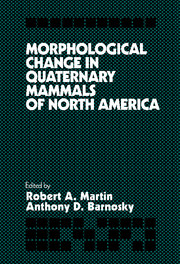Book contents
- Frontmatter
- Contents
- List of Contributors
- Acknowledgments
- 1 Quaternary mammals and evolutionary theory: introductory remarks and historical perspective
- 2 A method for recognizing morphological stasis
- 3 Mosaic evolution at the population level in Microtus pennsylvanicus
- 4 Variogram analysis of paleontological data
- 5 Morphological change in Quaternary mammals: a role for species interactions?
- 6 Rates of evolution in Plio-Pleistocene mammals: six case studies
- 7 Patterns of dental variation and evolution in prairie dogs, genus Cynomys
- 8 Quantitative and qualitative evolution in the giant armadillo Holmesina (Edentata: Pampatheriidae) in Florida
- 9 Evolution of mammoths and moose: the Holarctic perspective
- 10 Evolution of hypsodonty and enamel structure in Plio-Pleistocene rodents
- 11 Patterns of variation and speciation in Quaternary rodents
- 12 Decrease in body size of white-tailed deer (Odocoileus virginianus) during the late Holocene in South Carolina and Georgia
- 13 Short–term fluctuations in small mammals of the late Pleistocene from eastern Washington
- 14 Size change in North American Quaternary jaguars
- 15 Ontogenetic change of Ondatra zibethicus (Arvicolidae, Rodentia) cheek teeth analyzed by digital image processing
- 16 Morphological change in woodrat (Rodentia: Cricetidae) molars
- Index
13 - Short–term fluctuations in small mammals of the late Pleistocene from eastern Washington
Published online by Cambridge University Press: 15 December 2009
- Frontmatter
- Contents
- List of Contributors
- Acknowledgments
- 1 Quaternary mammals and evolutionary theory: introductory remarks and historical perspective
- 2 A method for recognizing morphological stasis
- 3 Mosaic evolution at the population level in Microtus pennsylvanicus
- 4 Variogram analysis of paleontological data
- 5 Morphological change in Quaternary mammals: a role for species interactions?
- 6 Rates of evolution in Plio-Pleistocene mammals: six case studies
- 7 Patterns of dental variation and evolution in prairie dogs, genus Cynomys
- 8 Quantitative and qualitative evolution in the giant armadillo Holmesina (Edentata: Pampatheriidae) in Florida
- 9 Evolution of mammoths and moose: the Holarctic perspective
- 10 Evolution of hypsodonty and enamel structure in Plio-Pleistocene rodents
- 11 Patterns of variation and speciation in Quaternary rodents
- 12 Decrease in body size of white-tailed deer (Odocoileus virginianus) during the late Holocene in South Carolina and Georgia
- 13 Short–term fluctuations in small mammals of the late Pleistocene from eastern Washington
- 14 Size change in North American Quaternary jaguars
- 15 Ontogenetic change of Ondatra zibethicus (Arvicolidae, Rodentia) cheek teeth analyzed by digital image processing
- 16 Morphological change in woodrat (Rodentia: Cricetidae) molars
- Index
Summary
A sustained local presence of terrestrial vertebrates, followed by burial and preservation, over an interval sufficiently long to record a population's evolution is an uncommon occurrence. In this chapter we describe a deposit that has preserved a relatively continuous faunal record of small land mammals from the late Pleistocene and early Holocene. In 1981 and 1982, field parties from the Burke Museum at the University of Washington collected approximately 15,000 bones and stratigraphic data from a roadside outcrop southwest of Kennewick in eastern Washington (Figure 13.1). Small vertebrates were obtained from the base of the exposed deposits to the uppermost beds. This report describes the depositional setting, the faunal composition and its changes, and the morphological changes in several local populations through the stratigraphic section.
Stratigraphy
General characteristics
The Kennewick Road Cut exposure is located approximately 11 km (7 miles) southwest of Kennewick, on highway 82, in the southwest quarter of Section 4, T. 7 N., R. 29 E., Pasco quadrangle. The exposure extends more than 140 m in a north–south direction along the west side of the highway (Figure 13.2). The locality lies at an elevation of 389 m in the southeast–trending Horse Heaven Hills.
The deposits consist of generally massive, tan–colored, poorly to moderately indurated silt ranging from 21 to 24 m in exposed thickness. Variations in thickness result from the north–south rise of the highway bed and the sloping surfaces of the hill. The most prominent sedimentary structures are a series of calcite–cemented layers (calcrete) that are typically less than 2 m in thickness.
- Type
- Chapter
- Information
- Morphological Change in Quaternary Mammals of North America , pp. 299 - 342Publisher: Cambridge University PressPrint publication year: 1993
- 12
- Cited by

